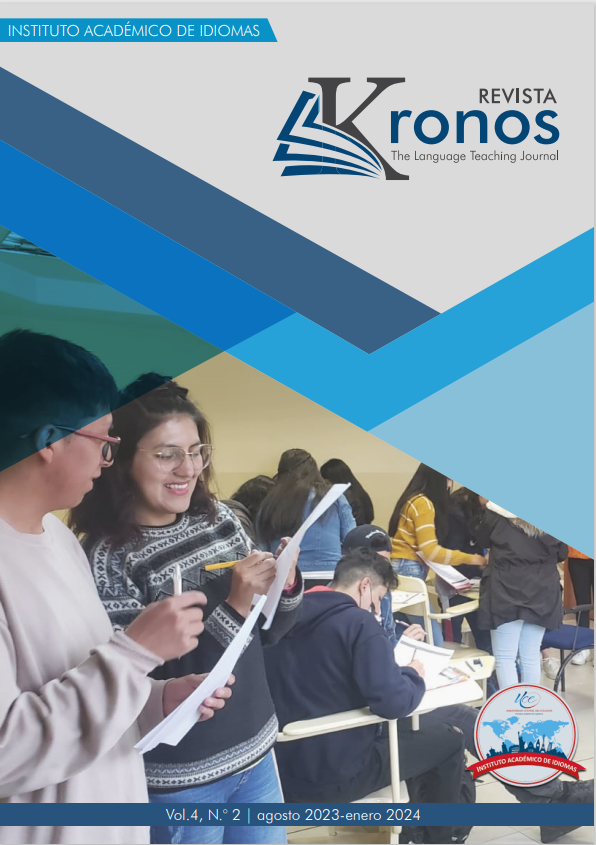Pilotaje de tres textos de inglés en la Universidad Nacional de Educación
DOI:
https://doi.org/10.29166/kronos.v4i2.4755Palabras clave:
Libro de texto, evaluación, EFL, universidadResumen
Este estudio tuvo como objetivo comparar tres libros de texto de inglés para demostrar sus ventajas y desventajas en un contexto de inglés como lengua extranjera (EFL) y determinar la mejor opción a utilizar. Los tres libros de
texto de inglés utilizados fueron Touchstone, English File y Headway. Los participantes fueron 187 estudiantes de la
Universidad Nacional de Educación (UNAE) en Ecuador. Este fue un estudio cuasi experimental donde se recopilaron
datos cuantitativos y cualitativos. Se aplicó una prueba previa y una prueba posterior a los estudiantes al inicio y al final del estudio. Además, se aplicó una encuesta a los estudiantes y una lista de verificación a los profesores para recopilar datos cuantitativos. Se utilizó una encuesta a los profesores con preguntas abiertas para recopilar los datos cualitativos.
Los resultados sugirieron que English File fue la mejor opción para nuestro contexto porque los estudiantes aprendieron mejor y aumentaron sus conocimientos de inglés en comparación con los otros dos libros de texto. Además, los profesores estuvieron de acuerdo en que English File es más útil porque tiene una variedad de recursos que reducen el tiempo de planificación de los profesores.
Descargas
Citas
Chambers, F. (1997). Seeking consensus in coursebook evaluation. ELT Journal, 51(3), 29-35. Retrieved from https://eclass.uoa.gr/modules/document/file.php/ENL264/textbook%20evaluation.pdf
Consejo de Educación Superior. (2019). Reglamento de Régimen Académico, (111) 80, 1-53.
Cunningsworth, A. (1995). Choosing your coursebook. Oxford, England: Heinemann.
Gutiérrez Bermúdez, J. F. (2014). An exercise in course-book evaluation: Strengths, weaknesses and recommendations regarding New English File: Elementary. Latin American Journal of Content and Language Integrated Learning, 7(1), 98-111.
Retrieved from laclil.unisabana.edu.co/index.php/LACLIL/article/download/3870/pdf
Hutchinson, T., & Torres, E. (1994). The textbook as agent of change. ELT Journal, 48(4), 315-328. Retrieved from http://textbookuse.pbworks.com/f/Textbooks%2Bas%2Bagents%2Bof%2Bchange.pdf
Jones, S. (2009). A retrospective evaluation of a ELT coursebook for a Korean university conversation course. MA TESOL / TEFL Module 3. Retrieved from https://www.birmingham.ac.uk/Documents/college-artslaw/cels/essays/sylabusandmaterials/JonesSM.pdf
Latham Koenig, C., Oxenden, C., & Seligson, P. (2012). New English File. Oxford University Press.
Ley Orgánica de Educación Superior (2014). Quito, Ecuador. https://www.ikiam.edu.ec/documentos/normativa_externa/REGLAMENTO%20GENERAL%20A%20LA%20LEY%20ORGANICA%20DE%20EDUCACION%20SUPERIOR.pdf
Lisna, M. (2016). Retrospective evaluation of ELT coursebook effectiveness. Advanced Education, 6, (87-92). Retrieved from https://pdfs.semanticscholar.org/b535/ac83fbcdceb8678d37621a772d1bcd2c8e9d.pdf?_ga=2.149816566.1166380568.1562450581-315612324.1562450581
McDonough, J., & Shaw, C. (2003). Materials and methods in ELT (2nd ed.). Oxford, England: Wiley-Blackwell.
McDonough, J., Shaw, C., & Masuhara, H. (2013). Materials and methods in ELT: A teacher’s guide (3rd ed.). Oxford, England: Wiley-Blackwell.
Mukundan, J., & Ahour, T. (2010). A review of textbook evaluation checklists across four decades (1970-2007). In B. Tomlinson & H. Masuhara (Eds.), Research for Materials Development in Language Learning: Evidence for best practice (pp. 336-352). London, England: Continuum International Publishing
Mukundan, J., Hajimohammadi, R., & Nimehchisalem, V. (2011). Developing an English Language textbook evaluation checklist. Contemporary Issues in Education Research, 4(6), 21-28. Retrieved from
Mukundan, J., Hajimohammadi, R., & Nimehchisalem, V. (2011). Developing an English Language textbook evaluation checklist. Contemporary Issues in Education Research, 4(6), 21-28. Retrieved from https://clutejournals.com/index.php/CIER/article/view/4383/4471
Richards, J. C., & Renandya, W. A. (2002). Syllabus design and instructional materials. In J. C. Richards & W. A Renandya (Eds.), Methodology in language teaching: An anthology of current practice (pp. 65-68). Cambridge, England: Cambridge University Press. https://doi.org/10.1017/CBO9780511667190.011
Scrivener, J., Norris, R., Kerr, P., Jones, C., & Clandfield, L. (2012). Straightforward. Oxford: Macmillan Education.
Shahmohammadi, S. (2018). Textbook Evaluation: Looking at Prospect Series through Teachers’ Perspective. Research in English Language Pedagogy, 6(2), 182-204. Retrieved from http://relp.khuisf.ac.ir/article_542578.html
Tomlinson, B. (Ed.). (2003). Materials development in language teaching (2nd ed.). Cambridge, England: Cambridge University Press.
Tu, N. T., Trang, B. L., & Phuong, H. T. (2013). An Evaluation of the EFL English coursebook: American English File Multipack 2A &2B. Tạp chí KHOA HỌC ĐHSP
Wilson, W., & Barnard, R. (2017). Fifty-Fifty, Book 1: A Speaking and Listening Course (3rd ed.). Person Longman.
Publicado
Cómo citar
Número
Sección
Licencia
Derechos de autor 2023 Veronica Herrera Caldas, Jessica Ochoa, Carmen Morales, Axel Calle

Esta obra está bajo una licencia internacional Creative Commons Atribución-NoComercial-CompartirIgual 4.0.












